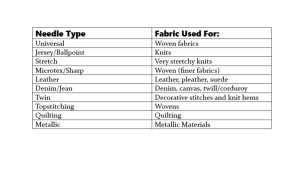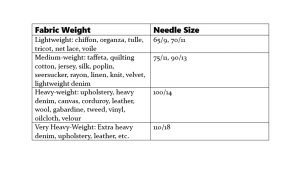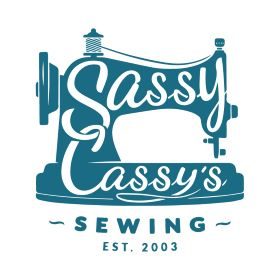Picture this: you run to the fabric store to pick up a new needle for your sewing machine. You thought it would be a simple “run in and run out” sort of scenario but when you approach the needle aisle, you are overwhelmed with all of the different needle options. Universal, stretch, microtex…size 9, size 11, size 14…what do you choose??
We’ve all been there in our sewing journey. I know we have because we’ve all been beginners at some point! It can be completely overwhelming to try and figure out what type and what size needle you need for any given project you are working on.
Don’t worry-I’ve got you! I’m going to break down all of your sewing machine needle types and sizes for you so that you can shop for your sewing machine needles with confidence and ease!
Needle types
First, let’s talk about needle types. Different fabrics will require you to use different needles. To the naked eye, all needles look the same. But if you put that needle under a microscope, you will see the shaft and the point of the needles are different for each type of needle. Some have sharper tips while others are more rounded (we’ll talk more about that in a minute). Some of the most popular needle types you will find include: universal, jersey/ballpoint, stretch, sharp/microtex, leather, denim/jean and twin needles. Let’s take a closer look at each needle.
Universal needles are used for most of your woven fabrics. The point of the needle glides through the weave of the fabric. The term “universal” actually refers to length of the shank of the needle, and not so much the point of the needle.
The point of this needle is more rounded, so it is designed to push the threads of the fabric out of the way rather than puncture through the fabric.
Stretch needles are for fabrics with a significant amount of stretch (more than your standard knit) such as lycra or spandex. They have a rounded tip and specialized scarf (that’s the long part of the needle) that helps prevent stitches from skipping.
These needles are more slender than the universal needles and are good for more fine wovens, as well as applique and quilting.
For fabrics with no weave, you will use a leather needle. This includes suedes, vinyl and any other non-woven fabric. The point of this needle is triangular and helps to puncture a clean hole in non-woven fabrics.
These needles are very sharp and pointy and are designed for more tightly woven fabrics, such as denim, corduroy, and canvas.
These needles stitch two rows of stitch lines at once. It is used for decorational purposes as well as hems on knits. They are usually accompanied with other needle makes, such as stretch, universal, etc.
Topstitching needles have a larger eye (for topstitching thread) and are extra sharp.
Quilting needles are a little sturdier than universal needles and help to get through layers of fabric without damaging it.
Metallic needles have a Teflon coating so that metallic threads won’t be shredded while sewing.
Here’s a needle chart for you at a glance:

SCHMETZ Universal (130/705 H) Household Sewing Machine Needles – Size 90/14-2 Cards – 20 NeedlesSCHMETZ Jersey (130/705H SUK) Sewing Machine Needles – Carded – Size 90/14
Schmetz Stretch Machine Needles 11/75
SCHMETZ Microtex (Sharp) (130/705 H-M) Sewing Machine Needles – Carded – Assortment
Schmetz Leather 5-Pk. Sz.16/100 (2 Pack)
SCHMETZ Denim 5-Pack Size 16/100
SCHMETZ Twin (130/705 H ZWI BR) Sewing Machine Needles – Carded – Assortment
SCHMETZ Topstitch (130 N) Sewing Machine Needles – Carded – Size 100/16
Quilt Machine Needles-Size 14/90 5/Pkg
SCHMETZ Metallic Sewing Needled Size 80/12
Needle Sizes
Now let’s talk about needle sizes. In case the type of needle wasn’t enough to consider, you also need to think about what size needle to choose for your project. The size of your needle will depend on the weight of your fabric. The more lightweight/fine your fabric is, the smaller the needle size; the heavier your fabric is, the larger your needle size will be.
You may have noticed that most needles come with two numbers on them. For example, you might pick up a pack of universal needles that say 80/12 on them. That doesn’t mean that there are two different sizes in the pack. 80 and 12 are the same size (one is the European measurement and the other is American). The following are the most common sizes you will find:
65/9
70/10
75/11
80/12
90/14
100/16
110/18
Here’s a little cheat sheet guide for you to know what size needle to select:

As you can see, there are many options when it comes to selecting needles for your sewing machine. It is very important to take into account your fabric type and fabric weight. Similarly, you’ll want to keep that in mind when selecting threads. Topstitching and quilting threads are a lot thicker and should be paired with larger needles, whereas lightweight threads would be best suited with smaller needles and all-purpose thread with your midweight needles…you get the point, right?
I hope this guide helps you in selecting which sewing machine needle is the right fit for your projects! If you have any question, drop them for me in the comments. If you found this information helpful, please share it with a friend! You can also pin it for later!
*Sassy Cassy’s is part of the Amazon Affiliate Program, which means that if you purchase Amazon items from this website, a small commission will be earned, at no extra cost to you.

